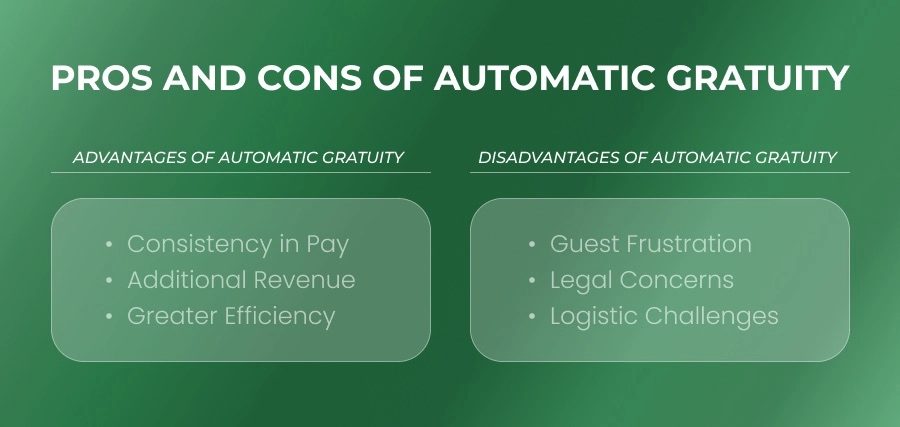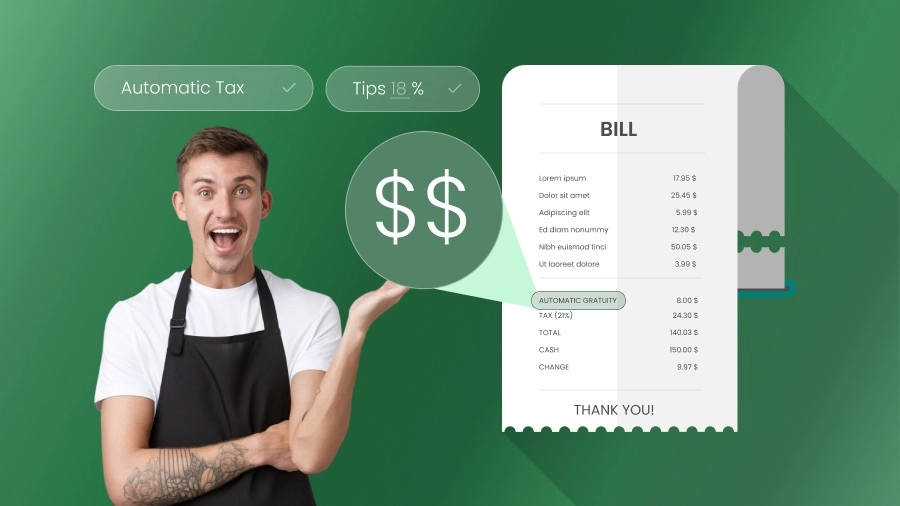What is Automatic Gratuity?
Many employees in the restaurant industry, particularly servers and other staff, rely on tips or gratuities to earn some extra money. In most circumstances, customers decide the amount that they pay as tips.

Due to this reason, restaurants, bars and other eateries impose automatic gratuity. Several laws govern the ability to impose these gratuities. For long term success, one must understand these laws and comply with the tax code for proper reporting of this type of income.

In recent times, restaurants have added automatic gratuity charges to the final bill which diners found confusing. It plays a unique role in restaurant bookkeeping and employee payroll.
Automatic gratuity is a charge that gets added to the bill amount of a restaurant customer.

Restaurants in which automatic gratuities are applied inform customers in advance through signs in the physical space or notice on the menu. Automatic gratuities are added to the bill for large parties to simplify checks and make tipping redundant. By doing so, the server who takes care of serving them food gets adequately compensated even if the customers split their bill or pay through separate checks. Automatic gratuity is also implemented in banquets and other functions, bars, nightclubs and even at hotels for room service.

What Is The Difference Between An Automatic Gratuity and A Tip?
Automatic gratuity is considered a tip when the:
- The customer gives it freely
- Customer has complete freedom to determine the tip amount
- Payment is not determined by an employer policy
- Customer decides the person who should receive the payment
If the above said four factors do not apply, then the automatic gratuity will be considered a service charge and not a tip.
Is Automatic Gratuity Legal?
The legalities regarding the US and Canada intersect and differ based on specific regions. Some states and local jurisdictions impose specific labor laws regulating the way automatic gratuity can be applied. A few states consider this gratuity as a wage that is subject to additional taxes and regulations. A few other states insist that information about automatic gratuities be displayed prominently on the menu or other printed materials.
The United States Internal Revenue Service, in 2014, determined that auto gratuity is a non-tip wage. This means that waiters do not go home with cash tips at the end of the day’s work but receive auto-gratuity tips that are added to their payroll. This gratuity is credited only after it is subject to social security tax, Medicare tax and federal income tax. Also, automatic gratuity cannot be distributed to non-service employees of the restaurant like restaurant owners or managers.
So, the waiters and restaurants have a choice – either get paid instantly and risk the whim of the customer or wait till payday to get a constant 18%.

The Canadian Restaurant and Foodservices Association also states that tips billed as an automatic gratuity are considered “controlled tips”. This type of tips is subject to taxes as the Canada Revenue Agency imposes source deduction payments on the employer and employee like wages.
So, restaurateurs must have profound knowledge about the specific labor laws in their location and consult with legal counsel before bringing the automatic gratuity into practice. Remember that failure to comply with labor laws will lead to legal action and penalties that mandate payments.

Advantages Of Automatic Gratuity
Consistency in Compensation
When an automatic gratuity is in force, restaurant waiters can be assured of receiving a consistent amount in their monthly pay – a percentage that is not affected by the customer’s whim or other unpredictable external factors.
Additional Revenue
When waiters receive a secure amount of additional compensation every month, they are encouraged to perform better, resulting in better customer service and repeat business. This increases the revenue of the restaurant.
Greater Efficiency
Automatic gratuity improves efficiency in waiter performance and overall restaurant operations. When it is in implementation, servers spend less time calculating tips or waiting for diners to add an amount while making payment. So, restaurant staff get to focus on significant elements like quality customer service and less on calculating and receiving individual tips.
Disadvantages Of Automatic Gratuity
Guest Frustration
Automatic gratuity could lead to dissatisfaction or frustration among guests. This is because some people might not be aware of the gratuity policy or might disagree with the amount that has been automatically added to their check. This leads to unsatisfied and negative reviews that ultimately damage a restaurant’s reputation. If the guests receive poor service or have a bad dining experience, they are sure to deem this gratuity amount as unfair or unnecessary.
Legal Concerns
There are several legal concerns governing the implementation of automatic gratuity. Restaurants must comply with such legal policies and the labor laws and regulations of their specific area to avoid getting into legal issues. Disclosure of the automatic gratuity policy must also be done in a proper manner to customers.
Logistic Challenges
The restaurant would require a robust billing system and resources (like an employee handbook) to flawlessly calculate and apply automatic gratuity. The staff must also undergo training to use this. If the restaurant decides to implement automatic gratuity only for certain tables or customers, it leads to logistic challenges for both the servers and the management in keeping track of the customers who have been charged additionally and those who have not.
Implementation Of Automatic Gratuity In The Restaurant
1) Keep The Guests Informed
The guests must be informed beforehand about the application of automatic gratuity to their bill. This means that the policy should be stated clearly on the menu, restaurant website and other communication materials. To mitigate any surprise or confusion during payment, the staff should be trained to inform customers about the policy when they are seated and before they place their order.
2) Set A Fair Gratuity Percentage
A fair auto gratuity percentage can be set by determining a reasonable amount to add to the bill reflecting the nature of service provided by the waiter. Typically, the range is 15% to 20%. Restaurant owners can set a higher or lower percentage, but it must not be excessive or unreasonable. Again, communicating about the application of automatic gratuity to the diners is highly essential.
3) Selective Application
Restaurants can also opt to selectively apply automatic gratuity to a few tables or certain customers of the restaurant. That is, this mandatory service fee can be applied only to large parties or specifically to people who do not have the habit of leaving a tip. This will reduce the chances of having frustrated guests in the restaurant or receiving negative reviews.
4) Suggested Tip Option
Restaurants can consider using the ‘suggested tip’ option instead of automatic gratuity. This approach will also help restaurateurs avoid legal complications associated with automatic gratuity laws while facilitating customers to leave a reasonable tip for the waiter. The suggested tip amount must be clear and reasonable and not pressurize customers to tip an amount that they feel is excessive.
Can Customers Refuse To Pay Automatic Gratuity?
Since automatic gratuity is classified as a service charge, a customer cannot refuse to pay it. While tipping is optional and given freely by customers, an automatic gratuity is a charge or mandatory fees that comes on the restaurant bill itself.

But, when the restaurant uses a ‘suggested tip’, the percentage is just a guideline for the diner and not a mandatory requirement.
Conclusion
Automatic gratuity is a great tool for restaurants that wish to ensure fair compensation for their servers, increase overall efficiency in employee performance and restaurant operations and largely improve income. All that restaurant owners must do is to examine the pros and cons of automatic gratuity before bringing it into force and ensure fairness and transparency in its implementation.
For more information on free restaurant website building, business enhancement and digital marketing, get in touch.
KEY TAKEAWAY!

